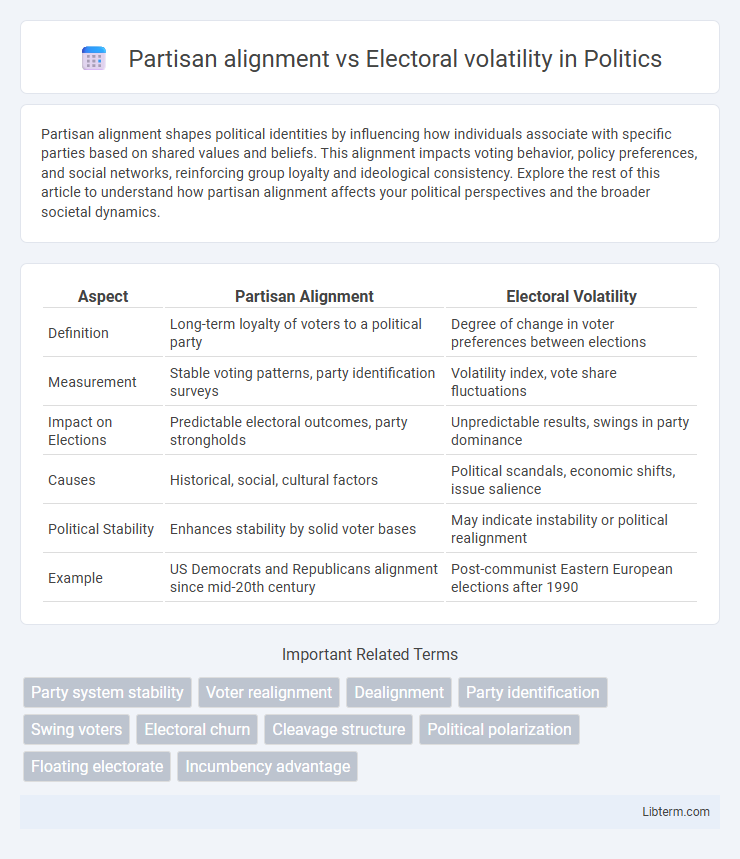Partisan alignment shapes political identities by influencing how individuals associate with specific parties based on shared values and beliefs. This alignment impacts voting behavior, policy preferences, and social networks, reinforcing group loyalty and ideological consistency. Explore the rest of this article to understand how partisan alignment affects your political perspectives and the broader societal dynamics.
Table of Comparison
| Aspect | Partisan Alignment | Electoral Volatility |
|---|---|---|
| Definition | Long-term loyalty of voters to a political party | Degree of change in voter preferences between elections |
| Measurement | Stable voting patterns, party identification surveys | Volatility index, vote share fluctuations |
| Impact on Elections | Predictable electoral outcomes, party strongholds | Unpredictable results, swings in party dominance |
| Causes | Historical, social, cultural factors | Political scandals, economic shifts, issue salience |
| Political Stability | Enhances stability by solid voter bases | May indicate instability or political realignment |
| Example | US Democrats and Republicans alignment since mid-20th century | Post-communist Eastern European elections after 1990 |
Introduction to Partisan Alignment and Electoral Volatility
Partisan alignment refers to the stable and consistent loyalty of voters to a particular political party over time, often influenced by factors such as social identity, ideology, and long-term policy preferences. Electoral volatility measures the degree of change in voter support between parties from one election to another, reflecting shifts in public opinion, party strategies, or external political events. Understanding the dynamics between partisan alignment and electoral volatility is crucial for analyzing election outcomes and predicting political stability.
Defining Partisan Alignment: Core Concepts
Partisan alignment refers to the stable and enduring loyalty of voters to a particular political party, deeply influenced by social identities, historical affiliations, and ideological convictions. It manifests in consistent voting patterns and party identification, serving as a foundation for political stability and predictability in elections. Understanding partisan alignment involves analyzing demographic factors, long-term socialization processes, and institutional influences that shape voter behavior across multiple election cycles.
Understanding Electoral Volatility: Key Metrics
Electoral volatility measures the degree of change in voter preferences between elections, typically quantified using the Pedersen Index, which calculates the net change in party vote shares. High electoral volatility indicates significant fluctuations in partisan alignment, reflecting voter realignment or fragmentation, whereas low volatility suggests stable party loyalty. Understanding key metrics such as vote share swing, net electoral change, and the effective number of parties helps analyze the dynamics between partisan alignment and electoral volatility.
Historical Trends in Partisan Alignment
Historical trends in partisan alignment reveal a decline in voter loyalty to traditional political parties, marked by increasing electoral volatility since the late 20th century. Studies indicate that this erosion of party idenfitication correlates with social and economic changes such as rising education levels and media fragmentation. Data from the American National Election Studies (ANES) show a significant reduction in straight-ticket voting and the rise of swing voters, underscoring shifting partisan dynamics.
Factors Influencing Electoral Volatility
Electoral volatility is significantly influenced by factors such as socio-economic changes, political scandals, and shifts in party policies, which disrupt traditional partisan alignment. Demographic transformations, including urbanization and generational replacement, also play a pivotal role in altering voter loyalty and increasing electoral unpredictability. Furthermore, media dynamics and the rise of issue-based voting contribute to fluctuating voter preferences beyond established partisan frameworks.
Impact of Partisan Alignment on Voter Behavior
Partisan alignment significantly shapes voter behavior by fostering consistent voting patterns and reducing electoral volatility; strong party loyalty enhances voter turnout and candidate preference stability. When partisan ties weaken, voter decisions become more fluid, increasing the unpredictability of election outcomes and enabling swings in voter support across election cycles. Therefore, the impact of partisan alignment is critical in maintaining electoral stability and shaping long-term political landscapes.
Relationship Between Partisan Loyalty and Electoral Shifts
Partisan alignment reflects voters' consistent loyalty to a political party, while electoral volatility measures the frequency and magnitude of changes in voter preferences between elections. High partisan loyalty often correlates with lower electoral volatility, as stable party identification reduces the likelihood of significant shifts in election outcomes. Conversely, weaker partisan ties can increase electoral volatility, leading to unpredictable voting patterns and fluctuating party support across electoral cycles.
Case Studies: Countries with High Electoral Volatility
Countries exhibiting high electoral volatility, such as Brazil, India, and South Africa, often experience weakened partisan alignment where voter loyalty to political parties shifts frequently across elections. In Brazil, the proliferation of new parties and personalized voting dilutes traditional party systems, leading to unpredictable electoral outcomes. Similarly, India's multiparty democracy showcases fluctuating voter preferences influenced by regional dynamics, while South Africa's transition from dominant-party rule highlights volatility as opposition parties gain ground and voter realignment occurs.
Consequences for Democratic Stability and Governance
Partisan alignment strengthens democratic stability by fostering consistent voter loyalty, which enhances policy continuity and effective governance. Electoral volatility disrupts this stability through frequent shifts in voter preferences, leading to fragmented legislatures and coalition instability. High volatility often results in policy unpredictability, undermining public trust and complicating long-term planning for democratic institutions.
Future Outlook: Navigating Partisan and Volatile Landscapes
Future electoral landscapes demand strategic adaptation to balance entrenched partisan alignments with increasing electoral volatility driven by demographic shifts and social media influence. Political actors must leverage data analytics and targeted messaging to anticipate voter behavior changes and maintain competitive advantage in fluctuating environments. Understanding the interplay between loyalty and volatility will define successful campaign strategies in emerging political ecosystems.
Partisan alignment Infographic

 libterm.com
libterm.com